Low Back Pain
(Part 2) |
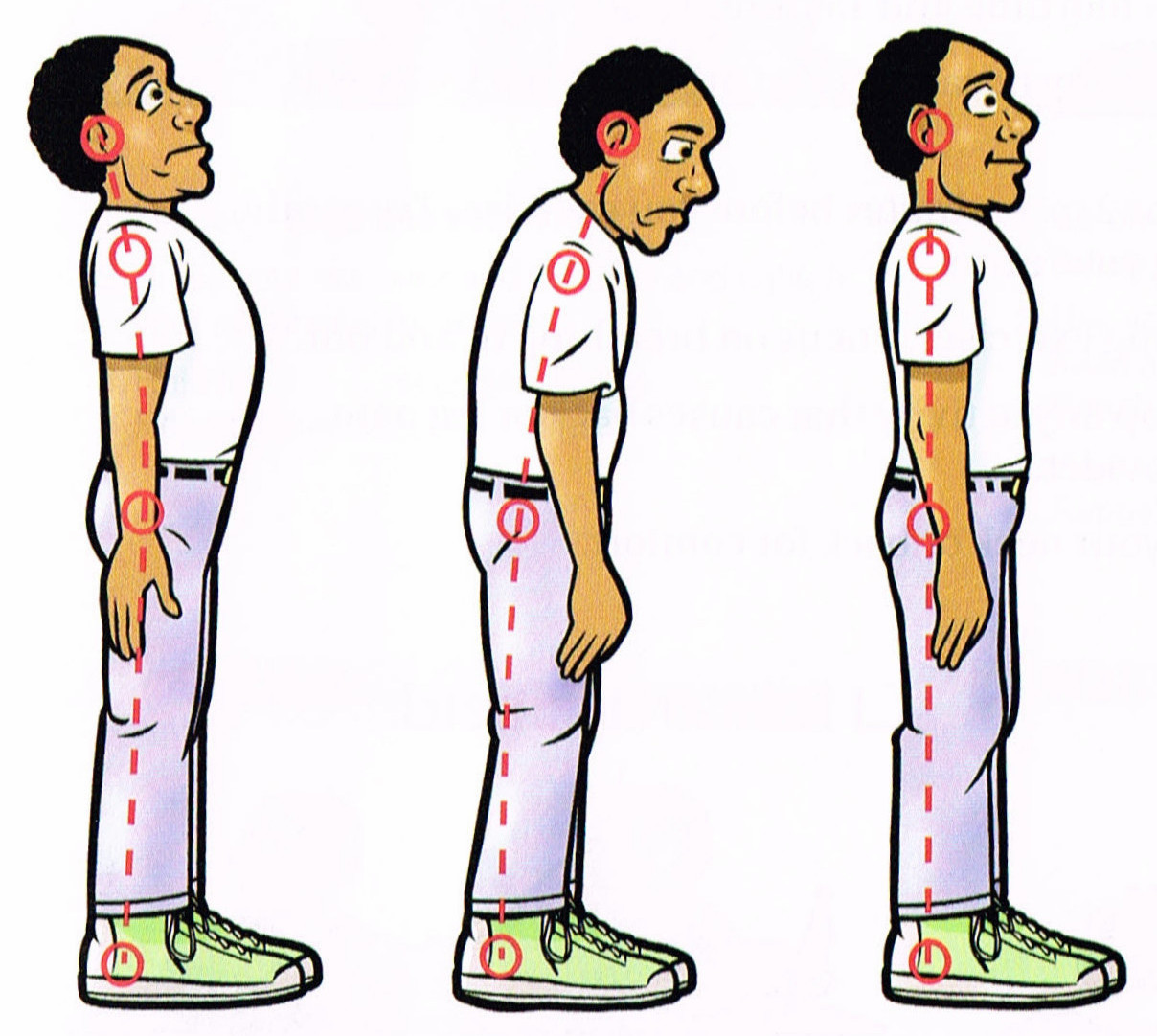
Good Posture Is Good for You
Poor posture
throws off the spine's natural curves. This can lead to back pain
and injury.
For example, poor posture can cause disks to wear out. But when you
practice proper posture,
you help keep the spine healthy and well aligned. This decreases
your risk of pain.
|
|

Military stance
Slouched stance Straight stance
makes the spine makes the spine
aligns the spine's
arch too much. round too much.
natural curves. |
Checking Your Posture
To test
your posture, stand with your back
against a wall. There should be only a small space between your
back
and the wall. Check to see
if you hold your back too swayed (like in the "military" stance) or if
you slouch forward. Military and slouched stances put added stress
on your back.
Improving Your Posture
It's not
too late to change your posture. Follow these steps to improve
your posture:
●
Breathe deeply.
●
Relax your shoulders, hips and knees.
●
Think of the ears, shoulders, hips and ankles as a
series of dots. Now, adjust your
body to connect
the dots in a straight line.
●
Tuck in your buttocks a bit if your back is swayed.
|
Reducing Stress on Your Spine
Your spine supports your body's weight. Certain positions put more
pressure on your back than others. For example, sitting puts more
stress on the back than walking. So do your best to limit
the amount of time you spend in the positions
that put the most stress on your spine.
|
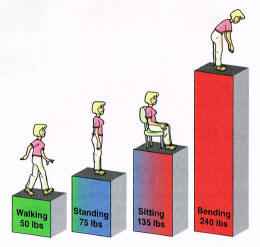
If you weigh 110 lbs, sitting
puts 135 lbs of
pressure on your back, but walking puts only 50.
|
|
Choose Your Exercise Program
A good
exercise program helps you stretch and strengthen the muscles that support
your back.
These muscles let the back be flexible and move naturally. Below are
examples of exercises
you can do to strengthen and stretch your muscles.
Be sure to
speak with your healthcare
provider before starting any exercise program.
Find exercises that work for you.
Move from basic to advanced exercises. And remember: Don't
overdo it! |
Play It Smart: Tips for a Safe Exercise Program
●
If you're recovering from a back program, do only the exercises suggested
by your
healthcare provider. If instructed, do
the exercises in this article daily. You might take
15 minutes in the morning and 15 minutes
at night.
●
Avoid occasional, excessive
exercising because it can hurt your back. Instead, do regular,
moderate activity.
●
Always warm up your muscles for 2 to
3 minutes before you exercise. Try marching gently
in place while moving your arms.
●
Don't hold your breath while doing
exercises. Focus on breathing in and out.
●
Expect a little discomfort, but stop
any activity that causes back or leg pain. Then, talk to
your healthcare provider.
●
If you prefer, put a pillow under
your neck or back for comfort.
|
Knee-to-Chest
Raise
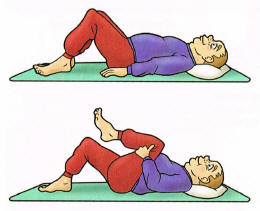
1. Lie
on your back with your knees bent. Keep
your feet flat on the
floor.
2. Grasp
your thigh behind the knee and slowly
pull it to your chest.
Keep your back flat
against the floor.
You will feel pulling in your
buttocks and low back.
3. Hold
for ........ seconds. Switch legs.
Repeat exercise ........ times.
|
Hamstring
Stretch
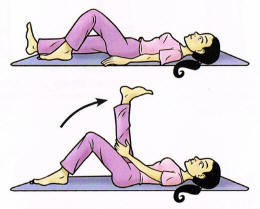
1. Lie
on your back. Lift your leg. Place your hands
around
your thigh, just above the knee (use a towel
if you have
trouble reaching around your thigh).
Then tighten your
abdominal muscles.
2.
Pull your leg toward your chest until you feel
pulling in
the back of the leg. Gently straighten
your leg as much
as you can.
3. Hold
for ........ seconds. Switch legs.
Repeat exercise ........ times.
|
|
Pelvic Tilt

1.
Lie down and bend both knees.
2.
Press your low back into the floor and
tighten your abdominal muscles.
3. Hold
for ........ seconds. Relax.
Repeat exercise ........ times.
|
Half Sit-Ups
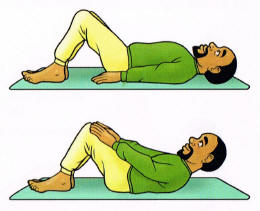
1.
Lie on your back with both knees bent, feet flat on
the floor,
arms by your sides.
2.
Use your abdominal muscles to raise your head and
shoulders slightly off the ground. Reach for your knees.
3. Hold
for ........ seconds. Relax.
Repeat exercise ........ times.
|
|
Calf Stretch
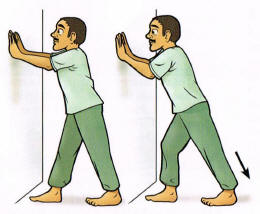
1.
Position yourself with your arms braced against
a wall.
Put one foot approximately 1½ feet behind
the other.
2.
Bend your front leg, while keeping both heels on
the floor.
Lean forward until you feel pulling in the
back of your
back leg. Do not bounce.
3. Hold
for ........ seconds. Switch legs.
Repeat exercise ........ times.
|
Wall Slide
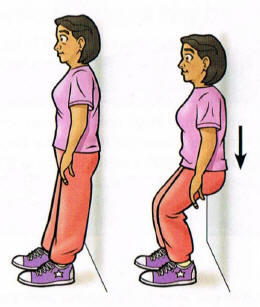
1.
Stand with your shoulder blades against the wall.
Place
feet about 4 to 6 inches in front of you,
shoulder-width apart.
Tuck in your buttocks.
2.
Slide down about 2 feet. Keep your back against
the wall.
Don't let your knees go past your toes.
3. Hold
for ........ seconds. Slide back up the wall.
Repeat exercise ........ times.
|
|
Advanced Exercises
Talk to your
healthcare provider before trying advanced exercises.
|
|
Press-Up
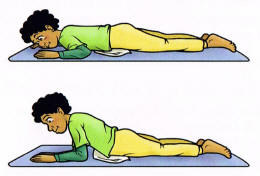
1. Lie
on your stomach with a pillow under your pelvis.
Place your hands on the
floor near the sides of your head.
2. Press
up on your elbows, slowly arching your back.
Hold this position for
........ seconds.
3.
Return to the first position and relax.
Repeat exercise ........ times.
|
Back
Extension
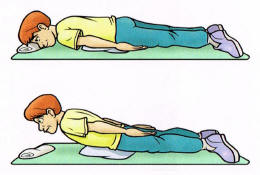
1.
Lie on your stomach with a pillow under your pelvis.
Put your hands by your sides.
2.
Slowly raise your chest off the floor, arms behind you.
Go only as high as feels comfortable.
3. Hold
for ........ seconds. Relax.
Repeat exercise ........ times.
|
|
Hip Extension
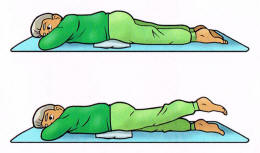
1.
Lie on your stomach with a pillow under your
pelvis.
2.
Straighten your left leg and tighten your buttocks.
Then slowly raise the left leg from the hip. Return
the leg to the floor.
Repeat exercise ........ times.
Switch legs.
|
Lower Back
Rotation
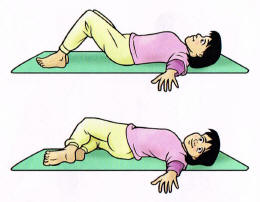
1.
Lie on your back with your knees bent. Put your feet
on the floor. Extend your arms out and place your
palms on the floor.
2.
Slowly drop both knees to one side while turning your
head to the other side; keep your shoulders to the floor.
3. Hold
for ........ seconds. Return to start.
Repeat exercise ........ times on each
side.
|
|
Relieve Back Pain
Aches and pains are your body's way of
telling you to pay more attention to your back.
Your back may need to be stretched or rested. Or, you may need to
ice it, apply
heat or take over-the-counter medications to help stop back pain. |
|
Rest Your Back
Certain positions help relax the back. They stretch the spine and
the muscles
that support it. Rest positions can also take pressure off the back.
So give your back a rest in these positions.
NOTE:
Do these positions only if instructed by your healthcare provider. |
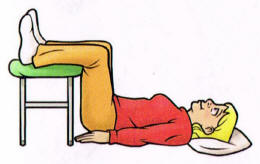
Lie on your back on the floor with your legs
up
on a stool. Put a pillow under your neck
for comfort. Hold for 15 minutes.
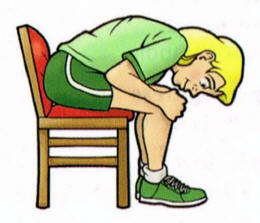
Lean forward in your chair.
Lower your head to the knees.
Hold for 1 minute.
|
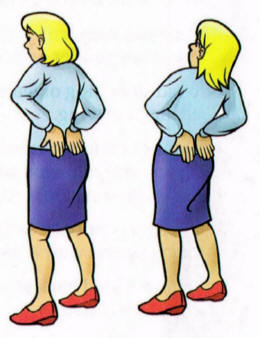
Stand with your hands on the low back.
Bend slightly back for 15 seconds.
Repeat 2 or 3 times. |
Treat Pain
To treat your
back pain, consider using:
●
Ice
to reduce swelling. Place an ice pack wrapped in a
thin towel
where your back hurts most. Keep it on for
15 to 20 minutes. Repeat this each hour. If you don't
have an ice pack, a bag of frozen peas will also work.
If ice hasn't relieved pain after 2 days, try heat.
●
Heat
to relax muscles. Put moist heat, such as a towel
heated with warm water, on the sore area for 10 to 15
minutes each hour. Taking a warm bath or shower may
also help.
●
Over-the-counter medicines
to reduce pain. Try using
aspirin, ibuprofen or naproxen. Talk to your
healthcare provider before taking any medications.
|
|
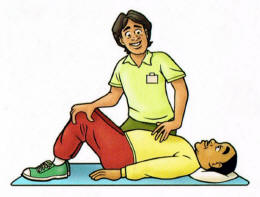
|
A Physical Therapist May Help
A physical therapist is trained to evaluate and
treat your back
pain. He or she will also plan
an exercise program
to help you treat yourself.
A physical therapist may practice mobilization (gentle movement of
the vertebrae).
Other treatments may include using machines
that produce cold, heat or electrical stimulation
to help treat your back
pain or injury.
|
Back's Maintenance Guide
●
Exercise daily to build strong, supportive muscles.
Walking and
swimming are great ways to
strengthen muscles.
●
Think before you lift. Always lift with your legs,
not with your back. Do this by squatting and
bending your knees. Hold
the object close to your
body when lifting. And ask for help with heavy
loads!
●
Maintain your back's natural curves by practicing
proper posture.
●
Avoid
slouching or leaning forward while sitting or
driving.
●
If
you sit for long periods, take time to get up and
walk around. If
you stand a lot, place one foot up
on a box or stool.
●
Sleep on your back or side on a mattress that
supports your back's
natural curves.
●
Relieve
added back strain by losing excess body
weight.
●
Quit smoking to reduce your risk of back pain and
injury.
●
Always talk to your healthcare provider about
concerns you may have about the health of your
back.
|
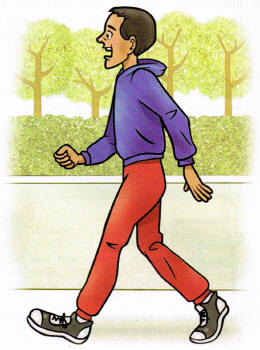
|
|
Top of Page |


![]()
![]()